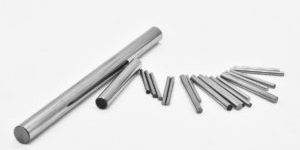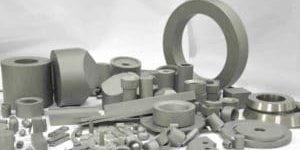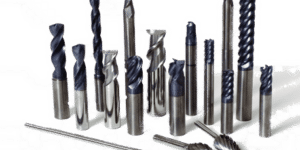Download
Our
Catalogs
- Unground tungsten carbide rod
- h6 polished carbide rod
- Cut-to-length carbide rod
- Coolant carbide rod
- Carbide Extension shank
- Carbide end mills
- Carbide drill bits
- Abrasive waterjet nozzles
- Carbide rotary burrs
- Custom cutting tool
Things you should know
Carbide
Terminology
CEMENTED CARBIDE
This refers to a sintered composite composed of refractory metal carbides and metal binders. Among the metal carbides currently used, tungsten carbide (WC), titanium carbide (TiC), tantalum carbide (TaC) and tantalum carbide (NbC) ) is the most common ingredient. Cobalt metal is widely used in cemented carbide production as a binder; other metal binders can also be used, such as nickel (Ni), iron (Fe), etc., for certain special applications.
DENSITY
This refers to the ratio of the mass to the volume of the material. Its volume also contains the volume of the pores in the material. Also known as the specific gravity.
The density of tungsten carbide (WC) was 15.7 g/cm3, and the density of cobalt (Co) was 8.9 g/cm3. Therefore, as the cobalt (Co) content in the tungsten-cobalt alloy (WC-Co) decreases, the overall density will increase. While the density of titanium carbide (TiC) is smaller than that of tungsten carbide, it is only 4.9 g/cm3, so if TiC is added, or other components with lower density, the overall density will decrease.
In the case of certain chemical composition of the material, an increase in the pores in the material leads to a decrease in density.
The density is measured by the drainage method (Archimed’s law).
HARDNESS
This refers to the ability of a material to resist plastic deformation.
Vickers hardness (HV) is widely used internationally. This hardness measurement method refers to the hardness value obtained by measuring the size of the indentation by using a diamond to penetrate the surface of the sample under a certain load condition.
Rockwell hardness (HRA) is another method of hardness measurement that is commonly used. It measures the hardness using the penetration depth of a standard diamond cone.
Both the Vickers hardness measurement method and the Rockwell hardness measurement method can be used for the measurement of the hardness of the cemented carbide, and the two can be mutually converted.
BENDING STRENGTH
The sample is multiplied as a simply supported beam on two fulcrums, and a load is applied to the centerline of the two fulcrums until the sample breaks. The value calculated by the winding formula is used according to the load required for the fracture and the cross-sectional area of the sample. Also known as transverse rupture strength or bending resistance.
In tungsten-cobalt alloy (WC-Co), the flexural strength increases with the increase of cobalt (Co) content of the tungsten-cobalt alloy, but when the cobalt (Co) content reaches about 15%, the flexural strength reaches the maximum value. start to fall.
The bending strength is measured by the average of several measured values. This value will also change as the geometry of the specimen, surface condition (smoothness), internal stress, and internal defects of the material change. Therefore, the flexural strength is only a measure of strength, and the flexural strength value cannot be used as the basis for material selection.
POROSITY
Cemented carbide is produced by the powder metallurgy process through pressing and sintering. Due to the nature of the process, traces of residual porosity may be present in the metallurgical structure of the product.
The residual void volume is evaluated using a map comparison procedure for pore size range and distribution.
Type A (A-type): less than 10 μm.
Type B (B-type): between 10 μm and 25 μm.
The reduction in porosity can effectively improve the overall performance of the product. The pressure sintering process is an effective means of reducing porosity.
DECARBURIZATION
After the cemented carbide is sintered, the carbon content is insufficient.
When the product is decarburized, the tissue changes from WC-Co to W2CCo2 or W3CCo3. The ideal carbon content of tungsten carbide in cemented carbide (WC) is 6.13% by weight. When the carbon content is too low, there will be an obvious carbon-deficient structure in the product.
Decarburization greatly reduces the strength of the tungsten carbide cement and makes it more brittle.
CARBURIZING
It refers to the excessive carbon content after sintering of cemented carbide.
The ideal carbon content of tungsten carbide in cemented carbide (WC) is 6.13% by weight. When the carbon content is too high, there will be an obvious carburized structure in the product. There will be noticeably excess free carbon in the product.
Free carbon greatly reduces the strength and wear resistance of tungsten carbide.
The C-type pores in the phase detection indicate the degree of carburization.
COERCIVE FORCE
Coercive force is the residual magnetic force measured by magnetizing a magnetic material in a cemented carbide to a saturated state and then demagnetizing it.
There is a direct relationship between the average particle size of the cemented carbide phase and the coercive force: the finer the average particle size of the magnetized phase, the higher the coercive force value.
MAGNETIC SATURATION
Cobalt (Co) is magnetic, while tungsten carbide (WC), titanium carbide (TiC), tantalum carbide (TaC) and tantalum carbide (VC) are non-magnetic. Therefore, firstly, the magnetic saturation value of cobalt in one material is measured, and then compared with the corresponding value of the pure cobalt sample, the alloying level of the cobalt binder phase can be obtained because the magnetic saturation is affected by the alloying elements. Therefore, any change in the binder phase can be measured. This method can be used to determine the deviation of the ideal carbon content because carbon plays an important role in composition control.
Low magnetic saturation values indicate the potential for low carbon content and decarburization.
High magnetic saturation values indicate the presence of free carbon and carburization.
COBALT POOL
After the metal cobalt (Co) binder and tungsten carbide are sintered, an excessive amount of cobalt may be generated, a phenomenon is known as a “cobalt pool.” This is mainly due to the fact that the sintering temperature is too low, the material forming density is insufficient, or the pores are filled with cobalt during the HIP (pressure sintering) treatment. The size of the cobalt pool is determined by comparing the metallographic photographs.
The presence of a cobalt pool in the cemented carbide may affect the wear resistance and strength of the material.
Ready to find out more?
Contact us today for more information!


